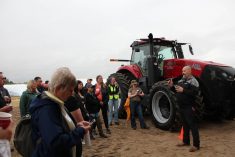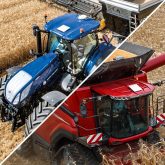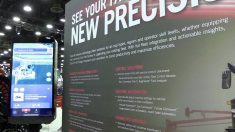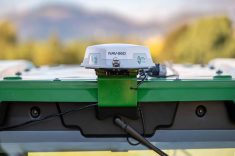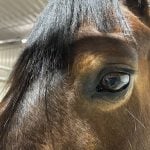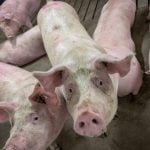It’s often said you need the right tools to do the job right. That is certainly the case in agriculture, where today’s farmer relies more and more on leading-edge technologies to push the boundaries of efficiency and production.
There’s no argument on that point from Shayla Wourms, who runs a family-owned grain farm in Saskatchewan along with her husband, Nick. Precision agriculture is a major focus on their farm and that means the right tools are an essential part of everyday operations. Wourms shared her experiences and insight on the importance of precision agriculture tools as part of a panel discussion at Canola Week 2022 held last month in Saskatoon.
“We’re only as good as the tools we’re using, so it’s important to be constantly doing research and exercising critical thinking skills at all times to make sure we are always pushing to be the best that we can be,” she said.
Read Also

Claas brings 1000 Series SP forage harvesters to Canada
In mid-August, Claas unveiled its new line of Jaguar forage harvesters at an event in Visalia, California, deep in the heart of that state’s dairy region.
“It’s about efficiency and effective use of resources. No one wants to spend more time (working) than they have to, and no one wants to spend more money than they have to. There’s also that economic and environmental sustainability (aspect).”
Precision forecasting
The Wourms farm three sections of land in northwestern Saskatchewan near the communities of St. Walburg, Turtleford and Makwa. A challenge with farming in three disparate regions, Wourms said, is that the weather can vary significantly between each location. That’s why they have installed independent weather stations at each farming site.
“We have independent weather stations because we are dealing with a large and diverse array of land,” said Wourms. “We need the weather to be precisely forecasted for us.”
Another major challenge is an abundance of hills on their land, ranging from gentle rolling mounds to steep rises. Headers and drills, including a Bourgault 3720 ParaLink Coulter Drill, must be capable of contouring to the changing landscape.
Drones have become an important tool for the Wourms. They have used them to map the topography and identify the location of deadhead rocks so they can be avoided during seeding and harvesting.
“We’re able to provide that pinpoint (location) on each of those rocks, so when it comes to harvest we have those deadheads flagged,” Wourms said. “We can weave around them and lift up the header manually at those points, just to make sure we’re not going to crush a header or ruin the drill there.”
She is excited about the future of drone technology, especially when it comes to spraying. Because their farm often must contend with excess moisture, especially in the Makwa region, drone spraying would allow them to reduce the use of heavy equipment on their fields, reducing the threat of soil compaction.
Wourms, who is also an educator with Agriculture in the Classroom Canada, said she also sees potential for drones and other forms of precision agriculture technology in attracting more young people to the ag industry.
“What we need to do is to have them understand why agriculture is important, to understand that base knowledge of agriculture and what it’s all about. Then we can highlight some of today’s challenges and technologies that are helping to provide solutions.”
Economic stability
Carl deConinck Smith operates a 10,000-acre grain farm along with his wife, Erica, their son and his parents near the town of D’Arcy, Sask. The operation was an early adopter of precision agriculture technology, which deConinck Smith said has played a key role in helping his family maximize profitability and ensure the long-term economic stability of their farm.
He said one of the most valuable pieces of tech on their farm is a Bourgault triple shoot air drill that features a large 1,300-bushel tank as well as individual scale tanks.
“The scale tanks have allowed our farm to do a couple of things,” said deConinck Smith, who spoke at the same Canola Week panel discussion. “We’ve basically been able to eliminate static calibrations, which can be a time-consuming operation when you’re switching from seed to seed and different fertilizers.
“The scale tanks also allow us to seed a wide variety of crops and eliminate cleanouts. At times we’ll even seed two different crops in the same day. We may seed lentils in the morning and canola in the evening. We don’t have time to do a lot of tank cleanouts and this tech really helps us to make things very efficient.”
A John Deere R4045 high clearance sprayer is another influential piece of equipment on deConinck Smith’s farm. It’s been hailed as the only dual mode sprayer in the world that combines optical spot spray technology with direct chemical injection. The sprayer can carry up to 800 litres of glyphosate, which can be injected separately from what’s in the main tank.
“(That) helps with efficiency and means I can change those rates on the fly in various parts of the field. It’s all about accuracy and being able to use (inputs) in a cost-effective manner and getting more chemical and groups on our plants,” he said, adding the technology has helped his farm realize savings of 30 to 90 per cent for fall burn-off applications, depending on weed pressure at the time.
However, deConinck Smith cautioned that spot spraying technology is a tool to maintain an already sound weed management system.
“You’ve got to fix it first and (then) use these systems to maintain what you’re already doing,” he said. “The No. 1 rule I use is you don’t use it on every field. It’s about knowing when to use the system and when not to use the system.”
The next big technological push on deConinck Smith’s farm will involve more autonomous equipment. His family already uses OmniPower, an autonomous power platform developed by Raven Industries, to run a 30-foot SeedMaster seeder and a 100-foot New Leader spreader on their farm.
“Our big reason for (doing) this is so we can do more acres with the same amount of labour,” deConinck Smith said.
No looking back
Rob Stone and his wife, Donna, operate Stone Farms near Davidson, Sask., where they grow canola, red lentils and wheat. They started adopting precision ag technology several years ago, including automatic steering on two tractors, and they haven’t looked back.
“Our motivation (with technology) is efficiency,” Stone said. “We want to make the most of every acre because it’s expensive to farm and also (to) reduce our environmental impact, perceived or actual. We do a really good job on the farm, and I think we need to do a better job of recording that and telling that story.”
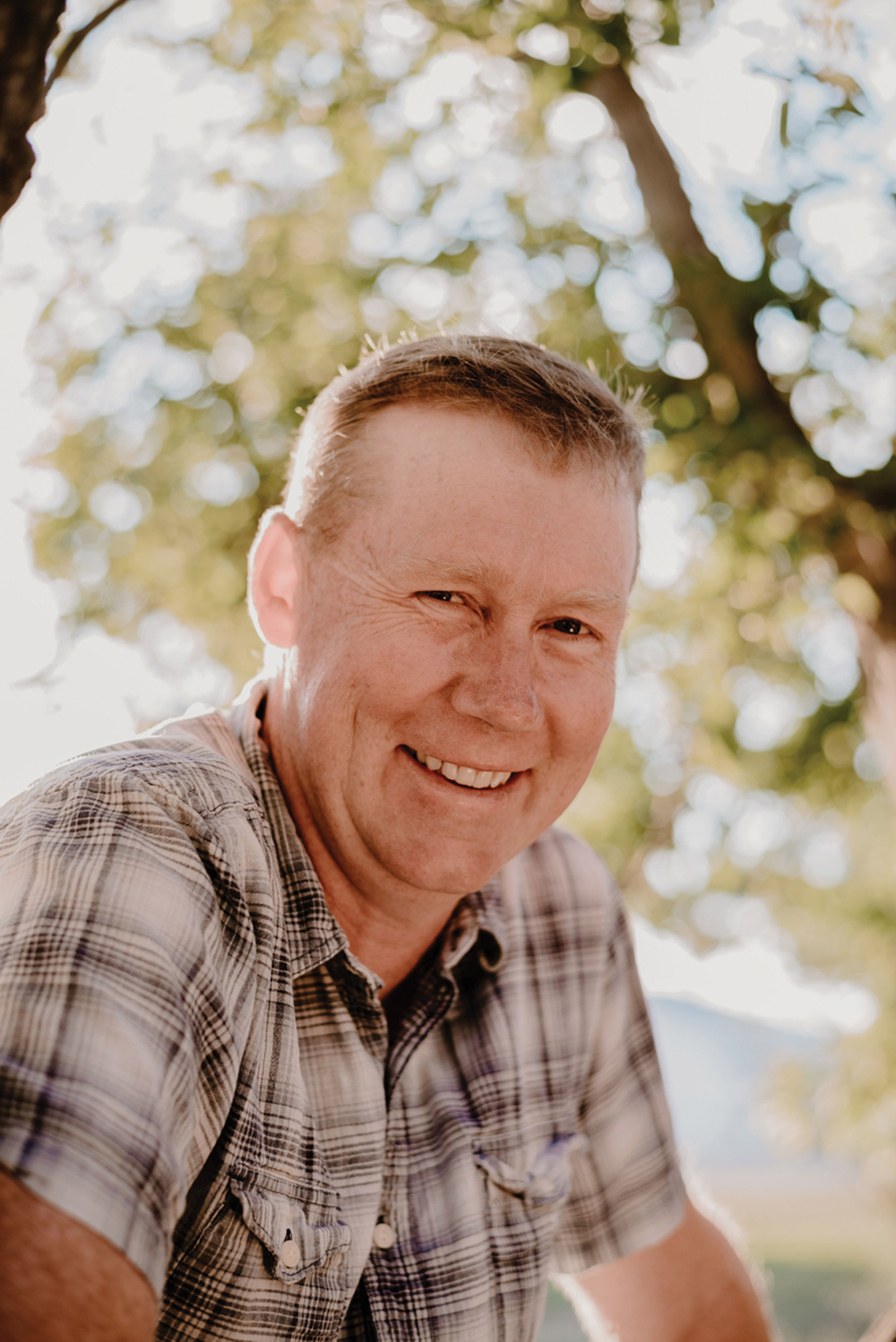
Stone said one of the most valuable pieces of equipment on his farm is an 84-foot Vaderstad Seed Hawk air drill that offers simultaneous control of multiple 10-foot sections.
“It’s really cut our overlap down. It’s probably about eight per cent (savings) over the solid seeding we were doing before,” he said.
Another piece of technology readily adopted by Stone Farms is crop intelligence sensors. These can interpret weather station data such as available moisture, accumulated rainfall and expected precipitation to model yield potential throughout the growing season.
“What they don’t do is make it rain, but they certainly tell you how much resource you have underneath your feet and that makes decisions at times very easy,” he said during the Canola Week panel discussion.
“The last couple of years we obviously didn’t have enough rain, but when we do get enough moisture and our soil starts to recharge, (the sensors) are very helpful in making decisions such as top dressing or seeing trends in terms of moisture use efficiency and other types of metrics that can help you figure out how to increase your production.”
Stone said he thinks robots will play an increasingly important role on farms as operating systems improve and farmers become more comfortable with the technology. This past year he used a robot to cruise rows of wheat and take pictures. It helped to scout for weeds and collected data on plant counts and insects.
The solar-powered robot was manufactured by Solinftec, a Brazilian automation company, and was deployed on Stone’s farm as part of its field-testing efforts in Canada. Solinftec is planning to return to the farm next season to conduct in-field trials with an eight-metre spot sprayer.
“Think of a Roomba going up and down a straight line and then returning to its base to recharge every so often at the end of the field,” Stone said with a laugh.
Finding a good fit
One of the most commonly asked questions when it comes to precision ag tech is how to know if it’s a good fit for your farm.
DeConinck Smith said the answer varies from farm to farm, but an operation typically needs to be at least 8,000 acres to realize a return on investment in technology such as spot sprayers. Based on current prices, a farm could realize a two-year payback for a spot sprayer used for fall application and spring burn-off.
“It’s all about opportunities and how many opportunities do you have to use spot spray technology,” he said.
Green-on-green spraying, which allows detection and spot treatment of weeds in a green crop, is a popular topic in any discussion on precision technology.
DeConinck Smith said it holds promise but likely won’t be the solution some people are hoping for, at least not immediately.
“I think what a lot of people don’t understand about green-on-green (technology) is we may get to where it’s eventually 100 per cent accurate, but it’s probably only going to be about 70 to 80 per cent accurate (initially).
“There’s a gap between what we all want to see (from) green-on-green and how it’s the Holy Grail of spot spraying. There’s a whole lot of stuff we … need to do before we get there. We need to learn to walk before we can run.”





